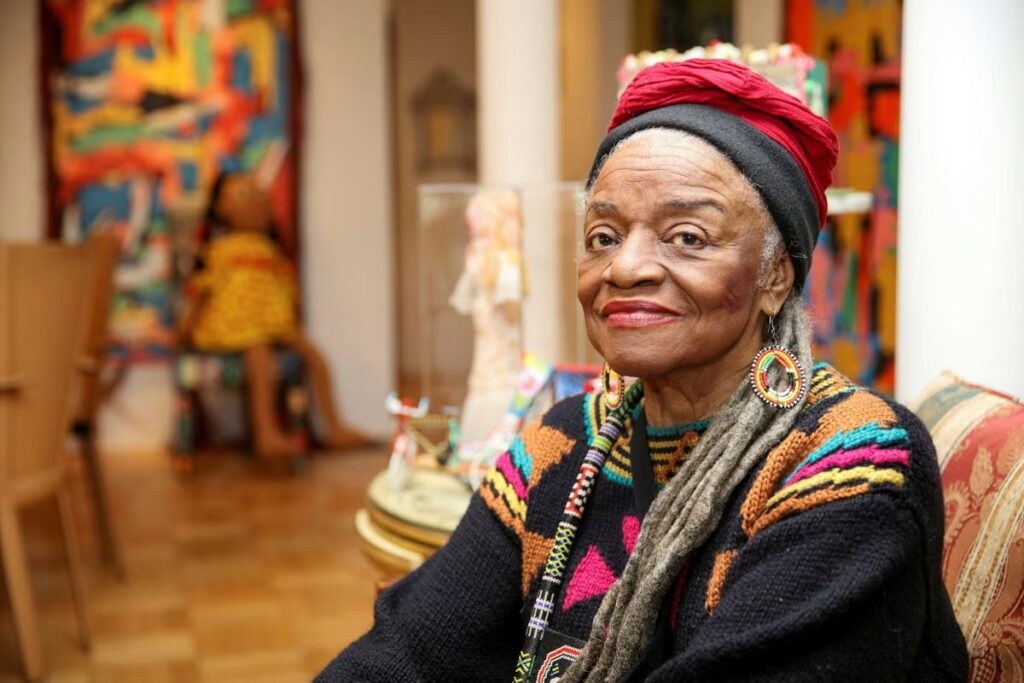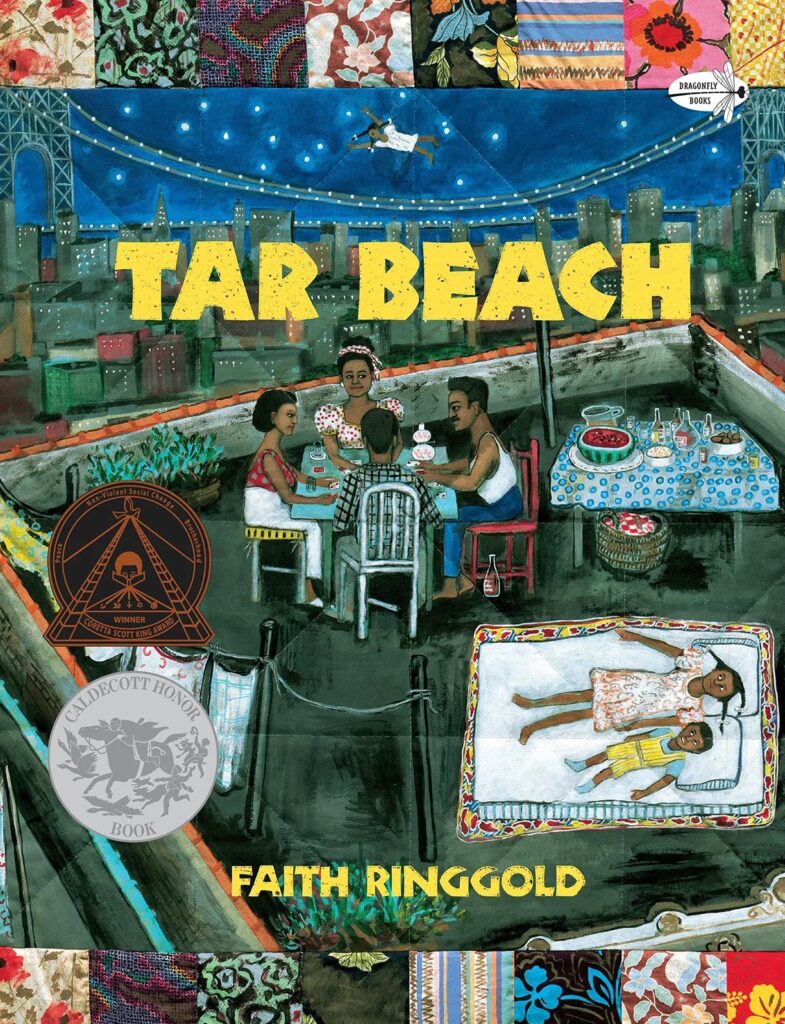Tracey Emin in 10 Artworks
Tracey Emin is one of the most prolific artists of our generation; perhaps one of the few capable of triggering such profound and disruptive emotions...
Guest Author 27 November 2025
27 November 2025 min Read
With the publication of Tar Beach in 1991, Faith Ringgold launched her career as a picture book author and illustrator. Her interest in picture books is directly related to the story quilts that she created in the 1980s and early 1990s. Here is the story of Ringgold’s transition from story quilts to picture books.
African American artist Faith Ringgold (1930–2024) transitioned from one artistic medium to another several times over the course of her long career. When Ringgold came to the attention of the art world in the early 1960s, she was known primarily for her oil paintings. She first became famous for her American People Series, which she painted between 1963 and 1967. She created these paintings in response to the Civil Rights Movement, and they often focused on the problem of racism in American society and culture.

Faith Ringgold. © DailyMail/Solo Syndication. Financial Times.
In the early 1970s, Ringgold began creating sculptural works, such as stylized masks and life-sized, soft sculptures made mostly from fabric. Her interest in fabric art led her to begin creating quilts. In 1983, she started writing on her quilts and called these new creations story quilts. In these story quilts, she combined painting, patchwork quilting, and sequential images. Many of the story quilts also include hand-lettered narratives that accompany the visual images.
In the 1990s, she transitioned to yet another artistic medium—the picture book. Her work as a picture book author and illustrator grew out of her earlier work in story quilts.

Faith Ringgold, Woman on a Bridge #1: Tar Beach, 1988, Solomon R. Guggenheim Museum, New York City, NY, USA. Museum’s website.
In the late 1980s, Ringgold started work on Woman on a Bridge, a series of five story quilts that include images of the George Washington Bridge. For much of her life, Ringgold had lived within sight of this bridge, and she often thought of it as her bridge. In 1988 she finished Tar Beach—the first part of the series. Then, in 1990, she produced another version of this quilt, Tar Beach 2.
The Tar Beach story quilts both include panels of text about a girl who has a special connection to the George Washington Bridge. The girl is named Cassie Louise Lightfoot and is largely based on Ringgold—the girl’s experiences relate to Ringgold’s memories of growing up in Harlem in the 1930s.

Faith Ringgold, Tar Beach 2, 1990, The Harold A. and Ann R. Sorgenti Collection of Contemporary African-American Art, Pennsylvania Academy of the Fine Arts, Philadelphia, USA. Museum’s website.
Soon after completing her Tar Beach story quilts, Ringgold decided to adapt these quilts into her picture book titled Tar Beach. She incorporated many of the visual images and textual panels from these two quilts, but she expanded on the narrative elements in the book version. Crown Books for Young Readers released the book in 1991 to great acclaim. The publication of Tar Beach launched Ringgold’s career as a children’s author, and it was an auspicious debut. She received both a Coretta Scott King Award for Illustration and a Caldecott Honor Award for the book.

Faith Ringgold, Cover of Tar Beach, 1991. The Walters Art Museum.
In the book, Cassie relishes the time she spends with her family and next-door neighbors on their “tiny rooftop,” which she calls her “Tar Beach.” Her parents put a mattress on the rooftop for Cassie and her little brother to sleep on while the adults are visiting and playing cards. For Cassie, “Sleeping on Tar Beach was magical. Lying on the roof in the night, with stars and skyscraper buildings all around me, made me feel rich, like I owned all that I could see.” In the context of the story, Cassie fantasizes that she can fly. The illustrations depict her soaring above New York City, claiming the George Washington Bridge and other landmarks as her own.
Ringgold portrays the rooftop as a liminal space where reality and fantasy merge. On the one hand, the rooftop is a place where the family eats dinner and socializes with the neighbors: “Tonight we’re going up to Tar Beach. Mommy is roasting peanuts and frying chicken, and Daddy will bring home a watermelon. Mr. and Mrs. Honey will bring the beer and their old green card table.”

Faith Ringgold, Illustration from Tar Beach, 1991.
On the other hand, the roof functions as the launching pad for Cassie’s night flights around the city, symbolizing a safe space where she feels secure enough to let her imagination take flight. In her fantasies, Cassie can help her father overcome the real-world discrimination he faces because he is half African American and half American Indian. In turn, she feels good about herself because she can make life better for her whole family. The rooftop is depicted as a recuperative space where Cassie feels safe, can let her guard down, engage her imagination, and cultivate her sense of self-worth.
Following the success of Tar Beach, Ringgold went on to write and illustrate many more picture books for children, including Aunt Harriet’s Underground Railroad in the Sky (1992), Dinner at Aunt Connie’s House (1995), My Dream of Martin Luther King (1996), If a Bus Could Talk: The Story of Rosa Parks (1999), Cassie’s Word Quilt (2002), and We Came to America (2016), which was her final picture book for children. In the end, she wrote and illustrated 17 picture books for children.
The art world did not fully embrace Ringgold’s picture books, but this response did not overly concern Ringgold. As she expressed in her memoir, We Flew over the Bridge: The Memoirs of Faith Ringgold, she created these books for children, not the art world:
The children’s books seek to explain to children some of the hard facts of slavery and racial prejudice, issues that are difficult but crucial to their education. But my books are even more about children having dreams and instilling in them a belief that they can change things.
We Flew over the Bridge: The Memoirs of Faith Ringgold, Duke University Press, Durham, 2005.
See Faith Ringgold read Tar Beach in the video below:
Author’s bio:
Mark I. West is a professor of English at the University of North Carolina at Charlotte, where he teaches courses in children’s and young adult literature. He has held many administrative positions at UNC Charlotte, including the Interim Chair of the Department of Art and Art History.
Faith Ringgold: Tar Beach, New York, 1991.
Faith Ringgold: We Flew over the Bridge: The Memoirs of Faith Ringgold, Durham, NC, 2005.
Zoé Whitley: “Summoning Ancestors, Inspiring Descendants: Faith Ringgold and Literature,” in Faith Ringgold: American People, Ed. by Massimiliano and Gary Carrion-Murayi, London and New York, 2022.
DailyArt Magazine needs your support. Every contribution, however big or small, is very valuable for our future. Thanks to it, we will be able to sustain and grow the Magazine. Thank you for your help!